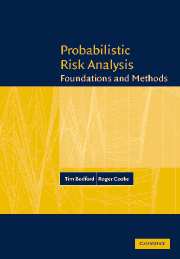Book contents
- Frontmatter
- Contents
- Illustrations
- Tables
- Preface
- Part I Introduction
- Part II Theoretical issues and background
- Part III System analysis and quantification
- 6 Fault and event trees
- 7 Fault trees – analysis
- 8 Dependent failures
- 9 Reliability data bases
- 10 Expert opinion
- 11 Human reliability
- 12 Software reliability
- Part IV Uncertainty modeling and risk measurement
- Bibliography
- Index
6 - Fault and event trees
from Part III - System analysis and quantification
Published online by Cambridge University Press: 05 June 2012
- Frontmatter
- Contents
- Illustrations
- Tables
- Preface
- Part I Introduction
- Part II Theoretical issues and background
- Part III System analysis and quantification
- 6 Fault and event trees
- 7 Fault trees – analysis
- 8 Dependent failures
- 9 Reliability data bases
- 10 Expert opinion
- 11 Human reliability
- 12 Software reliability
- Part IV Uncertainty modeling and risk measurement
- Bibliography
- Index
Summary
Fault and event trees
Fault and event trees are modeling tools used as part of a quantitative analysis of a system. Other semi-quantitative or qualitative tools such as failure modes and effects analysis (FMEA) are often performed in preparation for a more exact analysis. Such tools are outside the (quantitative) scope of this book, and the interested reader is referred to [Kumamoto and Henley, 1996], [Andrews and Moss, 1993]. These books also provide further information and more examples on fault tree modeling as does the Fault Tree Handbook [Vesely et al., 1981].
Fault tree and event tree analyses are two of the basic tools in system analysis. Both methodologies give rise to a pictorial representation of a statement in Boolean logic. We shall concentrate on fault tree analysis, but briefly explain the difference in the situations modeled by event trees and fault trees.
Event trees use ‘forward logic’. They begin with an initiating event (an abnormal incident) and ‘propagate’ this event through the system under study by considering all possible ways in which it can effect the behaviour of the (sub)system. The nodes of an event tree represent the possible functioning or malfunctioning of a (sub)system. If a sufficient set of such systems functions normally then the plant will return to normal operating conditions. A path through an event tree resulting in an accident is called an accident sequence.
Information
- Type
- Chapter
- Information
- Probabilistic Risk AnalysisFoundations and Methods, pp. 99 - 120Publisher: Cambridge University PressPrint publication year: 2001
Accessibility standard: Unknown
- 1
- Cited by
